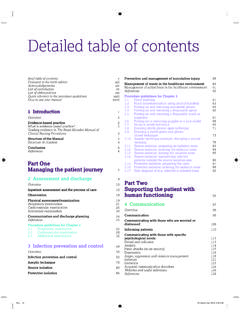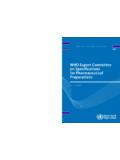Transcription of Chapter 1 Introduction - Royal Marsden Manual
1 Chapter 1. Introduction Sara Lister The Royal Marsden NHS Foundation Trust The Royal Marsden Manual of Clinical Nursing Procedures: Professional edition , ninth edition . Edited by Lisa Dougherty and Sara Lister 2015 The Royal Marsden NHS Foundation Trust. Published 2015 by John Wiley & Sons, Ltd. c01 1 28 August 2014 9:41 PM. The Royal Marsden Manual of Clinical Nursing Procedures 2. Overview and the environment safe. There are obvious ethical and moral This introductory Chapter gives an overview of the purpose reasons for this: Nurses have a moral obligation to protect those and structure of the book.
2 Nurses have a central role to play we serve and to provide the best care we have available' (Wilson in helping patients to manage the demands of the procedures 2005, ). Risk management has therefore become an integral described in this Manual . We also need to be mindful of the evi- part of day-to-day nursing work. For this reason, the risk manage- dence upon which we are basing the care we deliver. We hope ment implications of the areas of practice have been integrated that through increasing the clarity with which the evidence for into each Chapter .
3 The procedures in this edition are presented you will be better able to underpin the care you deliver to your patients in your day-to-day practice. The Chapter also highlights how the risk management impli- Evidence-based practice cations of the areas of practice are now integrated into each Chapter . The Chapter then goes on to explain how the structure The moral obligation described above extends to the evidence of the book is organized into three broad sections that repre- upon which we base our practice.
4 Nursing now exists in a health- sent, as far as possible, the needs of a patient along their care care arena that routinely uses evidence to support decisions and pathway. nurses must justify their rationales for practice. Where histori- The first edition of The Royal Marsden Hospital Manual of cally, nursing and specifically clinical procedures were based on Clinical Nursing Procedures was produced in the early 1980s as rituals rather than research (Ford and Walsh 1994, Walsh and a core procedure Manual for safe nursing practice within The Ford 1989), evidence-based practice (EBP) now forms an integral Royal Marsden Hospital, the first cancer hospital in the world.
5 Part of practice, education, management, strategy and policy. Implicit behind that first edition was the drive to ensure that Nursing care must be appropriate, timely and based on the best patients received the very best care expertise in carrying out available evidence. clinical procedures combined with an attitude of respect and compassion. What is evidence-based practice? Thirty years later these attitudes are still fundamental. The Evidence-based practice has been described by Sackett, a pio- Chief Nurse Jane Cummings has committed to make sure all neer in introducing EBP in UK healthcare, as: patients receive the very best care with compassion and clinical skill' (DH 2013).
6 The values and behaviours of this compassion- the conscientious, explicit and judicious use of current best ate practice are: Care, Compassion, Competence, Communication, evidence in making decisions about the care of the individual Courage and Commitment the 6Cs (DH 2013). This Manual of patients. The practice of evidence-based medicine means in- clinical procedures focuses on bringing together current evi- tegrating individual clinical expertise with the best available dence, acting as an essential resource for practice and providing external clinical evidence from systematic research' (Sackett the theory underpinning Competence, one of the 6Cs.)
7 Et al. 1996, ). This ninth edition focuses for the first time on procedures that are applicable in all areas of acute inpatient hospital care. (Pro- Despite the emphasis on research in EBP, it is important to note cedures specific to the care of the cancer patient can be found in that where research is lacking, other forms of evidence can be the new companion volume The Royal Marsden Clinical Cancer equally informative when making decisions about practice. Nursing Procedures.) The Manual is informed by the day-to-day Evidence-based practice goes much wider than research-based practice in the hospital and conversely is the corporate policy practice and encompasses clinical expertise as well as other and procedure document for the adult inpatient service of the forms of knowing, such as those outlined in Carper's seminal organization.
8 It therefore does not cover all aspects of acute nurs- work (1978) in nursing. These include: ing practice or those relating to children's or community nursing. However, it does contain the procedures and changes in practice empirical evidence that reflect modern acute nursing care. aesthetic evidence Core to nursing, wherever it takes place, is the commitment to ethical evidence care for individuals and to keep them safe so when and wher- personal evidence. ever the procedures are used, they are to be carried out within the framework of the Nursing and Midwifery Code, Appendix 1 This issue is evident throughout this Manual where clinical exper- (NMC 2008).
9 In respect of clinical competency, the NMC Code tise and guidelines inform the actions and rationale of the proce- states that you must: dures. Indeed, these other types of evidence are highly important as long as we can still apply scrutiny to their use. the knowledge and skills for safe and effective practice without Porter (2010) describes a wider empirical base upon which direct supervision nurses make decisions and argues for nurses to take into keep your knowledge and skills up to date throughout your account and be transparent about other forms of knowledge working life such as ethical, personal and aesthetic knowing, echoing recognize and work within the limits of your competence (NMC Carper (1978).)
10 By doing this, and through acknowledging AQ: 2008). limitations to these less empirical forms of knowledge, nurses Paley can justify their use of them to some extent. Furthermore, in 2006 not given in The Manual has been structured to enable nurses to develop com- response to Paley's (2006) critique of EBP as a failure to holis- ref list. petency, recognizing that competence is not just about knowing tically assess a situation, nursing needs to guard against Please supply how to do something but also about understanding the rationale cherry-picking, ensure EBP is not brandished ubiquitously and details.









